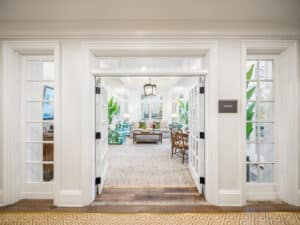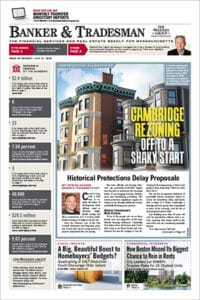
The Mitton House sunroom in The Newbury of Brookline development in Brookline. In addition to accessible design, successful senior housing developments build in plenty of connections to nature and expanded common space offerings. Photo by Raj Das Photography | Courtesy of Feingold Alexander Architects
There is an extremely high demand for senior housing in Massachusetts, at all price points.
Existing single family housing availability is low and insufficient to meet the demand for prospective homeowners. Today’s housing stock is also on average a lot older than the rest of the country.
Massachusetts architects and developers have an opportunity to provide beautiful and low-maintenance senior housing that will help address the housing crunch.
A senior living development, a community designed to cater to the needs of those 55 and up, has a lot of similarities to multifamily projects. While both of these building typologies serve residential purposes, the design approach for senior living facilities differs in some key ways from multifamily housing, starting with the way buildings are laid out.
Senior living facilities often offer a continuum of care within the same property, with assisted living and memory care residences in separate portions of the building or property to more easily accommodate resident’s changing health and abilities as they age.
Universal Design Needed
Consider unit layouts. In a senior living development, these all need to comply with accessibility requirements because of the increased likelihood of mobility challenges as residents age, above and beyond the accessibility code’s minimum requirements.
In practice, this means unit interiors have similar layouts but require more consideration for maneuvering with assistance from canes, walkers and assistants. This typically results in more open floor plans, more space in bathrooms and added convenience accessories including shower seats and grab bars.
But the need to design for all abilities doesn’t stop there. Senior living developments need to accommodate a variety of physical and cognitive ability levels.
Throughout a senior living development there needs to be more attention to aspects of the design that address hearing, sight and mobility. These include things like providing clear visual connections between spaces, incorporating higher contrast finish materials and minimizing or eliminating flooring material transitions.
Up Your Common Area Game
Multifamily projects often have common spaces for residents to create a “third space” outside of their apartment or condominium. This also includes first-floor commercial space used for cafes, offices or gyms, and other spaces like amenities.
But senior living developments need expanded common space offerings
For senior living residents it is important to provide quality amenity spaces focused on fostering community. Seniors are less likely to leave the facility so offering a variety of services on-site – a dining room, fitness center, healthcare treatment rooms, art rooms, a therapy pool – engage the community without the need to leave the campus.
Ideally these are located throughout the building to provide areas of repose for residents and come in a variety of scales to accommodate both structured and impromptu activities.

Mary McCarthy
Add Connections with Nature
Access to nature is important for all residents and their well-being. Studies have consistently shown that connection with nature through quality daylight and views have positive mental and physical health outcomes.
But it’s harder for all seniors to have quality connections with the outdoors and nature thanks to mobility challenges and other issues.
This makes nature connections important both in units and common spaces in senior living developments.
At the Newbury of Brookline project, designed by RAMSA as design architect and Finegold Alexander Architects as architect of record, the design features large exterior window openings and brings in aspects of nature indoors with the prints and colors that were used. There are also generous outdoor patios off the main common spaces to engage more directly with nature when the weather allows.
The demand for senior housing is at an all-time high and this trend will continue as the wave of Baby Boomer population increasingly looks to move into these communities. Based on the research conducted by the National Investment Center for Seniors Housing & Care, Boston has the highest senior housing occupancy rate in the country at 90.7 percent in 2025, closely followed by Baltimore and Cincinnati.
Let’s work together to develop more senior housing communities that provide connections and community for residents and the neighborhoods they serve to address today’s housing crunch.
Mary McCarthy is a senior associate at Finegold Alexander Architects in Boston.





